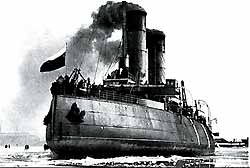|
Even
though I would consider myself a die hard imperial
German collector I could not pass on
the following group of documents, badges and photo. Who
was this man and what did those two badges represent?
Thanks to two
documents included with the group of decorations, used
during the immigration process into Austria during the
time of the III. Reich, we can identify him as mechanic
1st class of the air squadron at the Rumanian front
Ewgenij (Eugen) Karlowisch Hahn. A translated copy of
his army papers lists him also as a recipient of the
Imperial Russian Order of St. Anne and St. Stanislaus in
the 3rd Grade for distinguished service. Both are easily
identifiable common Russian order decorations and shown
in the picture above. Following the two documents:
But what do those two
badges represent?
After trying a
internet search on the years "1899-1901" the following surfaced:
"Admiral Makarov of the Russian Navy commanded
Yermak, the first icebreaker to venture into the Arctic seas in its expeditions of 1899 and 1901."[1]

the
icebreaker Yermak
Expanding on the
term "arctic" and the above mentioned year
bracket more interesting
and seemingly related information on the two badges
surface:
"Russian/Swedish
arc of meridian expedition (Russian section) from Tromsø;
June 26, 1899 - September 13, 1900. During the 1890s,
the Swedish and Russian governments agreed to conduct a
joint expedition to measure an arc of meridian over
about 4° of latitude in Svalbard, to help determine
more exactly the form of the earth. This expedition was
the min Russian contribution to the experiment. Sweden
had sent out a preliminary expedition the previous year
(see 1898[F]); like Russia, it send out its main
expedition in 1899 (see 1899-1900[B]). The Russian
established their base (named Konstantinovskoye) at Gåshamna
on the southern shore of Hornsund. A group of
astronomers sailed north from there on the icebreaker
Ledokol, intending to carry out geodetic work in the Sjuøyane,
but the ship was stopped by ice off northwest
Spitsbergen and returned to Hornsund. At the end of
July, the ships returned with geodesists to Storfjorden.
There two parties carried out the full program of
geodetic and astronomical work at Kapp Lee and
Kvalpynten, Edeøya, while a third erected station
signals at four points on the west coast of the fjord,
at Svanbergfjellet in the northeastern interior of
Spitsbergen, and at Mistakodden on Barentsøya.
After returning the parties to Hornsund, the ships
departed for Norway, leaving behind a wintering party of
19 men headed by Sergiyevskiy.
During March and April,
reconnaissance parties explored overland routes to the
two triangulation stations on the southeast coast of
Spitsbergen: Hedgehogfjellet and Keilhaufjellet. In
early May, two men occupied the latter station for the
main series of observations; an attempt to climb
Hedgehogfjellet for the same purpose was unsuccessful.
The ships arrived back with fresh supplies and a summer
prty on June 8 and 10. Soon after, one party left again
for the Hedgehogfjellet, and Bakan carried another party
to Boltodden on the Spitsbergen shore of Storfjorden. By
July 7, the expedition had regrouped at Hronsund, where
it was decided to explore the northeastern interior of
Spitsbergen, around Svanbergfjellet and Chydeniusfjellea.
Ten men and the expedition's dogs were landed in
Billefjorden on July 30 for this task. They established
a station and signal and made observations at
Newtontoppen in the Chydenius range, and at
Backlundtoppen, completing their work on August
30. Meanwhile, the ships carried the rest of the
expedition to Storfjorden to complete obersvations at
the station there. By early September, the greater part
of the Russians' work was finished, and the whole
expedition sailed back to Tromsø.
In addition to
this main objective, memebers of the expedition carried
out studies of geology, gravity,
meterology, and natural history. A Russian expedition
returned to Svalbard the following year to complete the
observations (see 1901 [B])."[2]
Hahn is listed as mechanic and winterer, Russian arc of
meridian exp. 1899-1900 [3]
He earned his badge staying behind as one of the 19 men
in Hornsund.
[1] Mary Katherine Jones, "Swedish Scientific Expeditions to
Spitsbergen, 1758-1908"; TijdSchrift voor Skandinavistiek vol. 29 (2008), nr. 1 & 2 [ISSN: 0168-2148]
[2] from Clive Holland.
"Artic Exploration and Development c.500 b.c. to 1915 an
encyclopedia" 1994, page 425
[3] from Clive Holland.
"Artic Exploration and Development c.500 b.c. to 1915 an
encyclopedia" 1994, page 592
© A. Schulze Ising, I/13
| 




